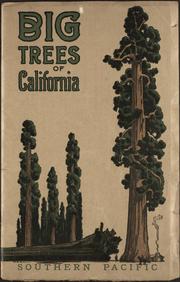
Big Trees of California Southern Pacific Company San Francisco, California (public domain)
Your Research Notebook is due on Thursday April 7 in class. The Notebook will record the materials you have gathered as well as your thoughts about the materials.
The most important element of the research notebook is the primary sources. Your primary sources may include a range of materials: photographs, documents, newspaper pages, political cartoons, works of art, diaries, transcribed oral histories, advertising, film or YouTube videos, drawings or illustrations, maps, memoir, autobiography, government documents, nonprofit board minutes, etc.
The secondary sources you have gathered for your project are part of your research; however, these secondary sources are best understood as other people’s projects-their explanations of California. That is, your work is to create your own project and then to use each secondary source (from, say, an artist, music critic, historian, or journalist) to help you do your work, to tell your story, to help you (and us) explain California.
Your Research Notebook will have five parts:
A Working Project Title. Please give the title some thought. The title should be descriptive. It should represent the progress you have made since the project proposal due date of March 10.
A One-Sentence Summary of the Project. The summary should describe the project and the purpose of the project. The purpose is how the project offers an interesting story on the natural and/or the cultural history of California.
A List of Primary Sources. Include the URL or print citation for each of the sources and write a one-sentence annotation for each source that describes the source and how you are using it.
A List of Secondary Sources. Include the full print citation (or the URL) for each of the sources and write a one-sentence annotation for each source that describes the source and how you are using it.
A Process, Method, and Product Statement. This statement will be 1-2 pages in length. I want to hear specifically what you have done during the past few weeks, what you are currently doing, and what you plan to do before submitting the first version of your project for review on Thursday April 21. Describe the changes that have taken place in your understanding of your project. Describe what you have learned. Describe what you want to share and why what you have to share matters. In almost every case the materials your are gathering will change what you set out to do. As you gather and organize materials you will be learning from each object as well as from the ways that the objects are beginning to fall into a relationship of some kind.
If for some reason you are unable to be in class on Thursday April 21 you will need to email me the project, or the link to the project site, no later than our class meeting time.
Primary Source Examples
The Shirley letters from California mines in 1851-52
A series of twenty-three letters from Dame Shirley (Mrs. Louise Amelia Knapp Smith Clappe) to her sister in Massachusetts, and now reprinted from the Pioneer magazine of 1854-55. Includes a synopses of the letters, a foreword, and a list of typographical and other corrections and emendations. The Shirley letters offer insight into the living conditions of a woman who came to California during the Gold Rush in the 1950s.
Mary Cone, Two Years in California 1876.
A resident of Marietta, Ohio, Mary Cone spent two years in California in the 1870s. Two years in California offers a nineteenth-century view (by a woman) of the the state’s history, climate, agriculture, and geography and a description of its regions: Southern California (San Diego, Los Angeles, Santa Barbara), the Sacramento and San Joaquin Valleys (with chapters on individual Sacramento ranches), Northern California’s redwoods and Mount Shasta and the same region’s other tourist attractions (San Francisco, Mount St. Helena). Separate chapters discuss the Chinese in California and the author’s visit to Yosemite.
Kim Stringfellow. The Mohave Project. mohaveproject.org. Accessed March 22, 2016.
The Mojave Project is an experimental transmedia documentary that explores the physical, geological and cultural landscape of the Mojave Desert. The themes of the project offer different but complimentary perspectives on the California Desert: Desert as Wasteland; Geological Time vs. Human Time; Sacrifice and Exploitation; Danger and Consequence; Space and Perception; Mobility and Movement; Desert as Staging Ground; Transformation and Reinvention.
Secondary Source Examples
Jo Ann Levy. They Saw the Elephant: Women in the California Gold Rush. Norman: U of Oklahoma P, 2014.
This book adds to the literature of the Gold Rush the experiences and stories of women in the California Gold Rush through letters, journals and reminiscences. The book offers excerpts from primary materials that will be useful for my project and a secondary source that helps add women’s experiences and social presence in California during the 1850s.
Albert L. Hurtado. Intimate Frontiers: Sex, Gender, and Culture in Old California. U of New Mexico P, 1999.
This book focuses on the history of the American frontier from the 1760s to the 1850s when the territory was controlled by Spain, Mexico, and the United States. The book focuses on sex and gender and race through social activities and family life in Native American, Anglo American, Hispanic, Chinese, and mixed blood persons and communities.
Please post questions about the project process in the “Leave a Reply” column at the bottom of the post. I will respond to the questions. And the whole class will have access to the questions as they arise.